In many parts of Canada, summer can be a hot and humid season. Many homeowners rely on home cooling systems to keep cool during the day and sleep comfortably at night.
Air conditioning systems are becoming more energy-efficient, cost-effective, and environmentally friendly. If you’re looking to upgrade or replace your cooling system, there are many choices to fit your specific needs. Here is a brief survey of the options available today.
Central Air Conditioners
The most common cooling system today is central air conditioning (AC). The two major components of this system are the evaporator coil and the condenser. Air is cooled and dehumidified by the evaporator coil and sent to the whole house through the ductwork. Heat is absorbed by refrigerant in the evaporator coil and pumped to the condenser, where it is released into the air.
Central AC can come as a split system or a packaged unit.
Split Central Air Conditioners
Among central AC systems, split central air conditioning is the most common. It’s called a split system because it’s split between the evaporator coil above your furnace or air handler in your home and the condenser unit outside your home. This option is more cost-efficient than a packaged system if you have a furnace.
Packaged Central Air Conditioners
In a packaged central AC, both the evaporator and condenser are in the same unit, which is usually installed outside the home on the ground. Warm air is pumped from the home where it is cooled and then returned through the ductwork.
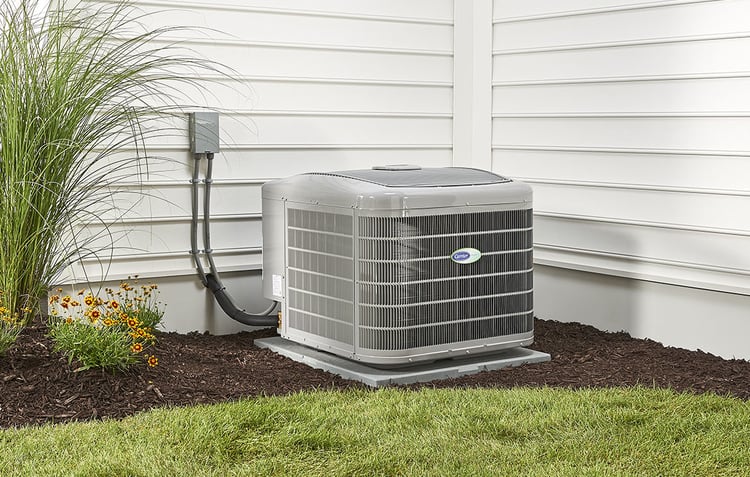
Pros
- Whole-house cooling
- More cost-effective than ductless AC
- Conveniently cools multiple rooms
- Low maintenance and reduced cost
Cons
- Individual room temperature control is not possible
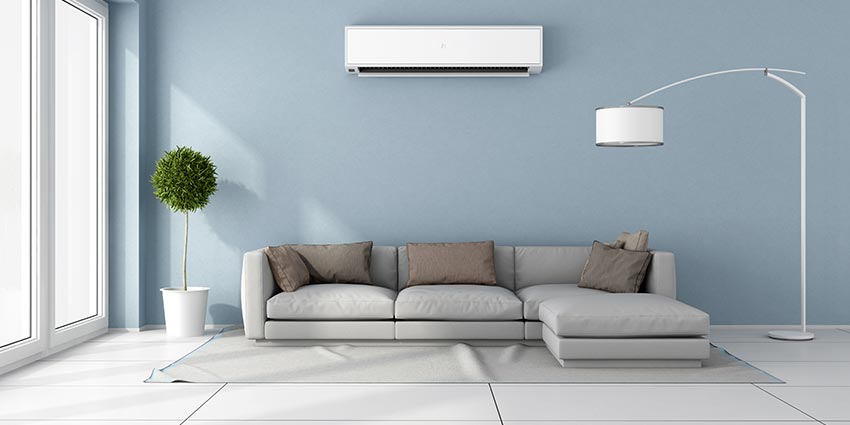
Ductless Split Air Conditioners
Some older homes don’t have the ductwork needed for central AC. A ductless split AC system can have multiple heads (indoor units) mounted on a wall, floor or ceiling. Each head cools only the air in the room where it’s installed, allowing you to set different temperatures for each room. Just like central AC, heat is absorbed by refrigerant sent to a condenser outside the house.
Pros
- Works in older houses without ductwork
- Temperature control by room
- Flexible placement
- Energy efficient
- Low noise levels
Cons
- More expensive than central AC
- Can’t be installed in every home
- Not the most aesthetically pleasing
Heat Pumps
A conventional air conditioner can only move heat out of a house. A heat pump can send heat out of a house and into it. It functions as both an air conditioner and a heater, which allows you to heat and cool without using your furnace until the coldest temperatures in winter.
Heat pumps function to move heat, not create it. This ability makes them one of the most energy-efficient heating and cooling systems available. The different types of heat pumps include air-sourced, ductless split, and geothermal heat pumps.
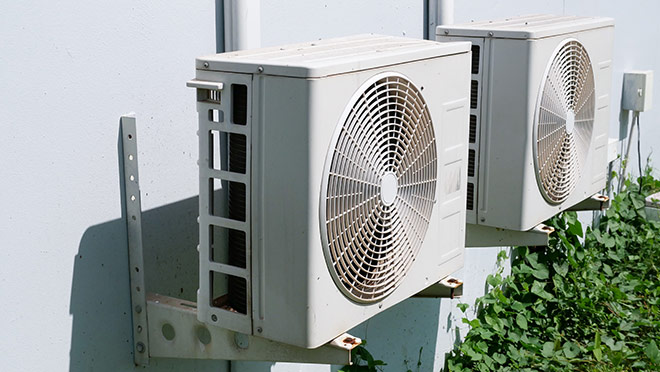
Pros
- Cooling and heating functions
- Furnace won’t be running as much, reducing CO2 emissions
- Reduced energy bills
- Temperature more even vs. a single-stage furnace
- Quiet
Cons
- Requires a backup furnace in cold climates
- Individual room temperature control is not possible
- Furnace backup required in cold climates
Air-Sourced Central Heat Pumps
Ductless Split Heat Pumps
Geothermal Heat Pumps
An air-sourced central heat pump acts like a conventional central AC system with an evaporator coil, condenser, refrigerant and ductwork. It functions as a cooling system when it absorbs heat and releases it outside. It works as a heating system when it collects heat from the outside air and sends it inside the house.
Pros
- Whole-house cooling
- Similar to conventional central AC
- Uses existing ductwork
Cons
- Individual room temperature control is not possible
- Furnace backup required in cold climates
A ductless split heat pump (“mini split”) is a good choice for older homes without ductwork. Like other split systems, the evaporator coil is located inside the house, and the condenser is outside. This system can have multiple indoor units to provide heat or cooling in different rooms.
Pros
- Works in older houses without ductwork
- More energy savings than ducted systems
- Temperature control by room
Cons
- High installation costs
- Not always aesthetically pleasing
A geothermal heat pump operates similarly to an air-sourced heat pump but transfers heat between your home and the ground using liquid instead of air. Because temperatures in the ground are more even, geothermal can operate more efficiently during the hotter and colder days of the year.
Pros
- Can reduce energy costs by up to 65%
- Environmentally friendly
- No flames, fumes, odours, or carbon monoxide
- Last longers, with less ongoing maintenance, than other systems
- Heating and cooling ability
Cons
- Most expensive system to install
- May require a large land area
- Not all soil types allow for installation
Portable Air Conditioners
A portable (“windowless”) air conditioner sits on the floor and can be moved from room to room. These mobile air conditioning units release heat through a window vent, and the moisture can be sent outside or collected in a container. Portable air conditioners are effective in cooling small spaces like garages, dens, recreation and computer rooms.
Pros
- Effective in spot cooling a single room
- Easy and quick to set up
- Moves from room to room
- Won’t cover up your window with a bulky window unit
Cons
- Noisier than other types of AC
- Not the most aesthetically pleasing
- Takes up floor space
- May impact the look and function of one of your windows
- Limited cooling capacity
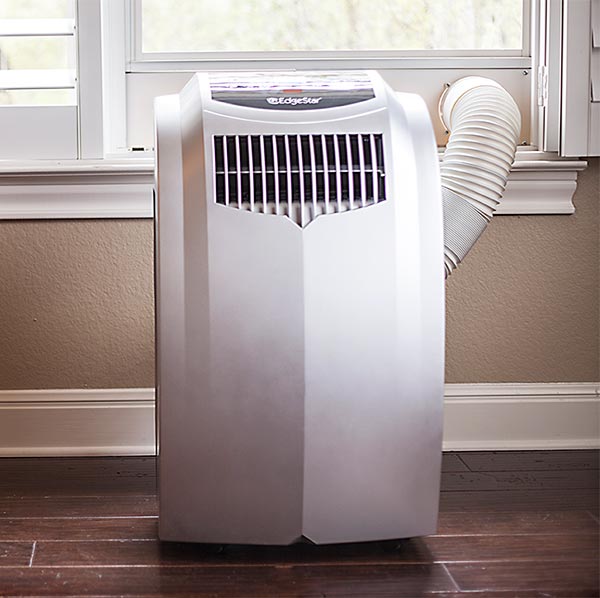
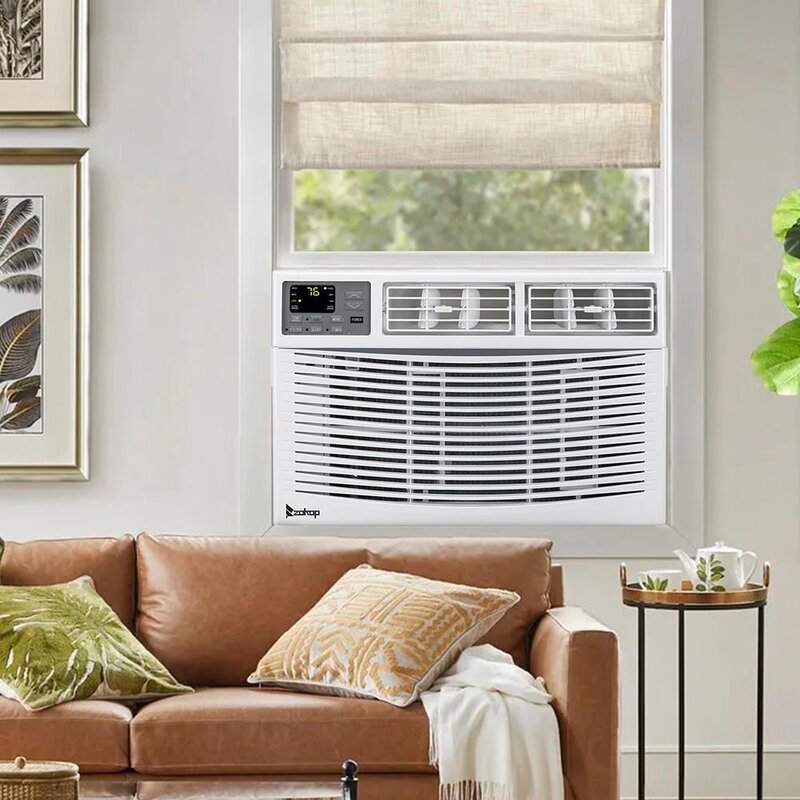
Window Air Conditioners
Window ACs fit into an open window frame in your home and are primarily used to cool one room. A window AC takes cools air with an evaporator coil and blows it back into the home. The condensed moisture drips onto the ground outside your home.
Pros
- Relatively easy to install
- Cools a specific room in your home
- The only option in some living spaces like older apartments
Cons
- Noisier than other types of AC
- Not the most aesthetically pleasing
- Impacts the look and function of one of your windows
- Limited cooling capacity
The House
Explore the different components of the house.

